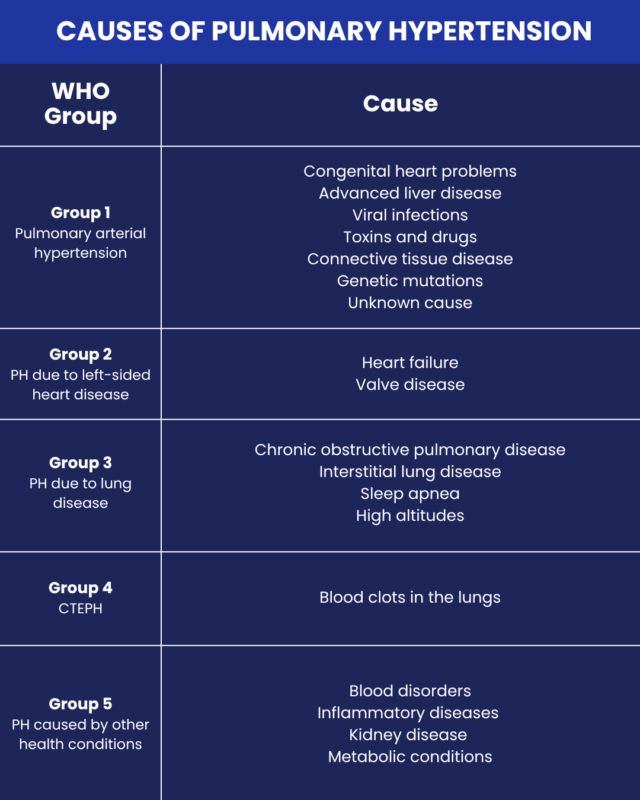Causes of pulmonary hypertension
Last updated Oct. 31, 2025, by Lindsey Shapiro, PhD

There are numerous possible causes of pulmonary hypertension (PH), a disease characterized by abnormally high blood pressure in the pulmonary arteries, the vessels that transport blood from the heart to the lungs.
High blood pressure in the lungs makes the heart work harder to pump blood, limiting oxygen transport throughout the body and leading to PH symptoms such as shortness of breath, chest pain, fatigue, and heart problems.
There is no single main cause of PH. It can develop due to various underlying health conditions, medications, or genetic factors. Sometimes, the specific PH causes are unknown.
Understanding what causes PH in each case is essential for reaching a PH diagnosis. This helps clinicians accurately evaluate a patient’s prognosis and choose the appropriate PH treatment.
The World Health Organization classifies PH into five main groups based on the underlying cause.
Pulmonary arterial hypertension (PAH)
Group 1 includes pulmonary arterial hypertension (PAH), where the pulmonary arteries become narrowed, thickened, or stiff, which then restricts blood flow and raises pressure. It has many potential causes, including:
- heart abnormalities, such as congenital heart disease
- viral infections, such as HIV/AIDS
- connective tissue diseases, such as scleroderma or lupus
- toxins and drugs, such as methamphetamines or cocaine
- chronic liver disease
When certain congenital heart defects are not corrected early in life, they can lead to Eisenmenger syndrome, a severe form of PAH in which pressure in the lungs becomes so high that the direction of blood flow reverses and deoxygenated blood is mistakenly circulated through the body.
Various congenital issues can cause this, but the most common is a ventricular septal defect, where there’s a hole between the heart’s left and right ventricles.
Some cases of PAH result from genetic mutations inherited within families, known as heritable PAH. Several genes have been linked to this condition, with BMPR2 being the most common.
Not all cases of PAH have a known cause; this is called idiopathic PAH.
PH caused by left-sided heart disease
Group 2 includes cases of PH caused by issues with the left side of the heart, which receives oxygen-rich blood from the lungs and pumps it to the rest of the body. This may include:
- left-sided heart failure, where the lower left chamber of the heart, known as the left ventricle, doesn’t work as it should to pump blood out to the body
- a thickening of the left ventricle, or hypertrophy, that stiffens and weakens it
- left-sided valve disease, where the valves that connect certain parts of the heart to ensure blood flows in the right direction don’t work properly
Left-sided heart disease impairs normal blood flow, raising pressure in the left side of the heart. That pressure backs up into the lungs, leading to PH.
PH caused by lung disease
Group 3 PH is caused by chronic lung disease or other conditions that result in low oxygen levels. The body’s response to inadequate oxygen is to constrict, or tighten, the arteries in the lungs, which increases pressure there. Conditions that can lead to Group 3 PH include:
- chronic obstructive pulmonary disease (COPD)
- pulmonary fibrosis or other forms of interstitial lung disease
- sleep apnea, where breathing frequently pauses during sleep
- chronic exposure to high altitudes
PH caused by chronic blood clots
Group 4 PH mainly includes chronic thromboembolic pulmonary hypertension (CTEPH), which occurs due to chronic blood clots in the lungs.
These clots and the scarring they cause block normal blood flow and raise pressure.
PH induced by other health conditions
Group 5 includes cases of PH that occur secondarily to other health conditions. This may include, but is not limited to:
- blood disorders, such as sickle cell disease or polycythemia vera
- inflammatory conditions such as sarcoidosis
- chronic kidney disease
- metabolic conditions, such as Gaucher disease, glycogen storage disease, or thyroid disorders
- tumors
These conditions may therefore be considered PH risk factors, although how they lead to PH is not well understood.

Pulmonary Hypertension News is strictly a news and information website about the disease. It does not provide medical advice, diagnosis, or treatment. This content is not intended to be a substitute for professional medical advice, diagnosis, or treatment. Always seek the advice of your physician or other qualified health provider with any questions you may have regarding a medical condition. Never disregard professional medical advice or delay in seeking it because of something you have read on this website.
Recent Posts
- Pulmonary hypertension improves in most premature infants with BPD
- Potential therapeutic target could halt PAH progression, rat study finds
- Phase 3 trials now recruiting people with PH-HFpEF to test TNX-103
- Uptravi improves physical capacity in children with PAH: Study
- When living with chronic illness, life often gives you lemons







